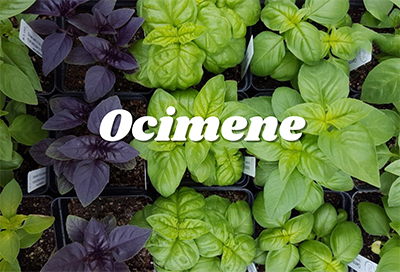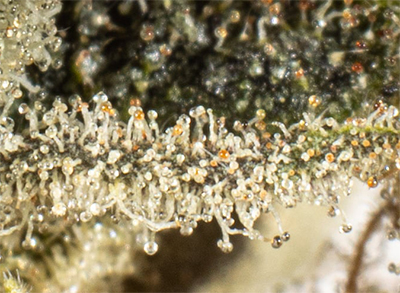Cannabis, a plant renowned for its many uses, contains a myriad of compounds that contribute to its effects and benefits. Among these compounds are terpenes, aromatic molecules that not only provide the distinctive scents and flavors of cannabis but also play significant roles in its therapeutic properties. One such terpene is ocimene, a lesser-known yet intriguing component of the cannabis plant. Below, we look into the characteristics, benefits, and potential applications of ocimene, shedding light on its importance within the cannabis landscape.
Read about different terpenes here: Myrcene, Pinene, Terpinolene, Linalool, Caryophyllene, Humulene & Camphene.
What is Ocimene?
 Ocimene is a monoterpene, a type of terpene consisting of two isoprene units, and it is characterized by its sweet, herbaceous, and citrusy aroma. It is found in a variety of plants beyond cannabis, including mint, parsley, basil, orchids, and mangoes. Ocimene is a volatile compound, meaning it evaporates easily at room temperature, contributing to the fragrance profile of the plants it inhabits.
Ocimene is a monoterpene, a type of terpene consisting of two isoprene units, and it is characterized by its sweet, herbaceous, and citrusy aroma. It is found in a variety of plants beyond cannabis, including mint, parsley, basil, orchids, and mangoes. Ocimene is a volatile compound, meaning it evaporates easily at room temperature, contributing to the fragrance profile of the plants it inhabits.
Chemically, ocimene exists in several isomeric forms, including alpha-ocimene, beta-ocimene, and allo-ocimene, each differing slightly in molecular structure. These isomers can influence the terpene’s aroma and potential effects.
The Role of Ocimene in Cannabis
In cannabis, ocimene contributes to the plant’s overall aroma and flavor profile. It is often associated with strains that have a fruity, sweet, or floral scent. Beyond its olfactory contributions, ocimene plays a role in the plant’s defense mechanisms. Like many terpenes, ocimene has antimicrobial and antifungal properties, helping protect the cannabis plant from pests and pathogens.
Ocimene in Aromatherapy
Aromatherapy, the practice of using essential oils for therapeutic purposes, has embraced ocimene for its pleasant aroma and potential health benefits. Essential oils containing ocimene, such as basil and lavender, are often used in aromatherapy to promote relaxation, reduce stress, and improve mood. Ocimene’s sweet and uplifting scent makes it a popular choice for creating a calming and refreshing environment.
Ocimene in the Cannabis Industry
 In the cannabis industry, ocimene is gaining recognition for its unique contributions to the sensory and therapeutic profiles of different strains. Breeders and cultivators are increasingly selecting for terpene-rich strains, including those high in ocimene, to enhance the overall cannabis experience for consumers. Strains known for their ocimene content often boast distinctive aromas and flavors that set them apart in a crowded market.
In the cannabis industry, ocimene is gaining recognition for its unique contributions to the sensory and therapeutic profiles of different strains. Breeders and cultivators are increasingly selecting for terpene-rich strains, including those high in ocimene, to enhance the overall cannabis experience for consumers. Strains known for their ocimene content often boast distinctive aromas and flavors that set them apart in a crowded market.
Popular Cannabis Strains Containing Ocimene
Several well-known cannabis strains are noted for their ocimene content, including:
Clementine: This sativa-dominant strain is famous for its citrusy aroma and energizing effects, attributed in part to its high ocimene levels.
Jack Herer: A classic strain named after the cannabis activist, Jack Herer combines a piney, citrus scent with uplifting and creative effects, thanks to its terpene profile that includes ocimene.
Golden Goat: Known for its tropical and sweet aroma, Golden Goat is a hybrid strain that provides a balanced experience, with ocimene contributing to its unique scent.
Amnesia: This sativa strain is renowned for its potent effects and citrusy, floral aroma, with ocimene playing a significant role in its terpene profile.
Challenges and Considerations
While ocimene holds promise, there are challenges and considerations to keep in mind:
Research Gaps: Much of the research on ocimene is still in its early stages. More rigorous studies, including clinical trials, are needed to fully understand its therapeutic potential and mechanisms of action.
Variability in Terpene Profiles: The terpene content in cannabis can vary significantly based on factors such as cultivation methods, genetics, and environmental conditions. This variability can affect the consistency of ocimene levels in different strains.
Regulatory Hurdles: The legal status of cannabis and its derivatives varies widely across regions, impacting research, production, and access to ocimene-rich products. Navigating these regulatory landscapes can be challenging for researchers and businesses.
Future Directions
 The future of ocimene in the cannabis industry and beyond looks promising. As research progresses, we can expect to see a deeper understanding of its therapeutic properties and potential applications. Here are some potential future directions:
The future of ocimene in the cannabis industry and beyond looks promising. As research progresses, we can expect to see a deeper understanding of its therapeutic properties and potential applications. Here are some potential future directions:
Enhanced Cultivation Techniques
Advancements in cultivation techniques, such as selective breeding and genetic modification, may allow for the development of cannabis strains with optimized terpene profiles, including higher ocimene content. These strains could cater to specific consumer preferences and therapeutic needs.
Targeted Therapeutic Products
As our understanding of ocimene’s health benefits grows, we may see the development of targeted therapeutic products, such as ocimene-infused topicals, tinctures, and inhalers. These products may offer natural alternatives for managing inflammation, respiratory issues, and other health conditions.
Integration into Holistic Health Practices
Ocimene’s potential in aromatherapy and holistic health practices may continue to expand. Integrating ocimene-rich essential oils into wellness routines could provide a natural way to enhance relaxation, mood, and overall well-being.
Sustainable Agriculture
Ocimene’s antimicrobial and antifungal properties could contribute to more sustainable agricultural practices. By leveraging natural compounds like ocimene, farmers could reduce their reliance on synthetic pesticides and promote healthier crop cultivation.
Conclusion
Ocimene is a fascinating and multifaceted terpene with a range of potential benefits and applications. From its role in cannabis aroma and flavor to its promising therapeutic properties, ocimene offers a glimpse into the complexity and richness of the plant kingdom. While more research is needed to fully unlock its potential, ocimene stands out as a valuable component of cannabis and a subject of growing interest in the fields of medicine, agriculture, and wellness. As we continue to explore the depths of this terpene, we move closer to harnessing its full spectrum of benefits for human health and beyond.

